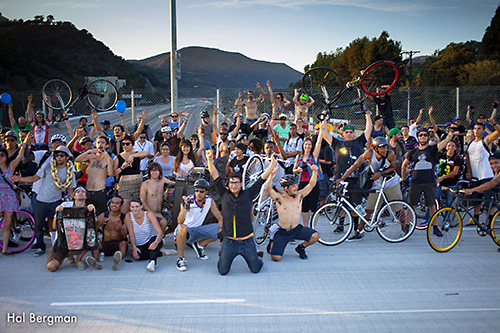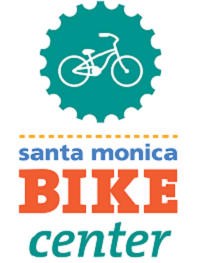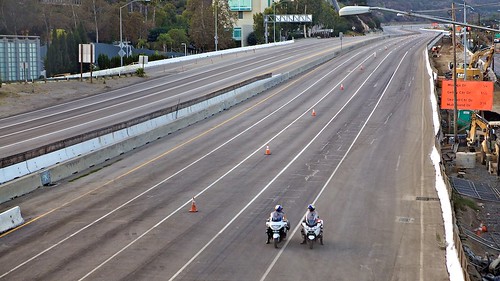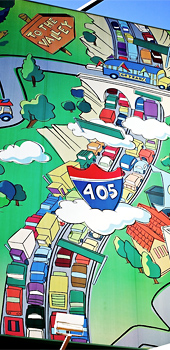Carmageddon II, Fun Times & Flawed Infrastructure Priorities
12:16 PM PDT on October 1, 2012

There were some fears that the second coming of “Carmageddon”, a full closure of the 405 between the I-10 and the I-101, might really bring the disastrous traffic jams that were imagined but never materialized the last time around. By all accounts, traffic was no worse this weekend in Santa Monica and the Westside than any typical sunning idyllic weekend. Sam Morrissey, City Traffic Engineer for the city of Santa Monica reported “Santa Monica calmer than a usual sunny Saturday. No real traffic impacts.” If UCLA's research last time was any indication, the air was dramatically cleaner.
At the same time that contractors were furiously destroying perfectly good infrastructure, people all over Los Angeles were celebrating the absence of cars on the 405, bicyclists especially. The LACBC organized Westside rides appeared to be a hit. I saw one of those groups go by with at least 100-200 riders. C.I.C.L.E. also hosted an event for those on the other side of the hill, ensuring our friends in the Valley weren't left out of the fun.
I took part in the Midnight Ridazz "Carmaheaven" ride, the final details of which came together at the last minute. The event involved many of the same people that put together the Flight Vs. Bike event last year, myself included, and led by Don "Roadblock" Ward. Don & Joe Anthony (who was a Jet Blue racer in Flight Vs Bike) of Bike Commute News made brief television appearances on NBC expressing their thoughts on the ride and opportunities a freeway closure represents.
Though modest in pace, the Carmaheaven ride was several hundred strong, and fairly epic in scope. The ride started at the new Grand Park in Downtown Los Angeles, after feeder rides and transit riders came from as far away as Pomona. The ride included a viewing of the 405 at the Sunset bridge (pictured above), and concluding with a nighttime bonfire at Dockweiler Beach under a full Harvest Moon. The fact that a major automobile artery is shut down feels like a holiday, one that locals bars even name mixed drinks after, does say something about a shift occurring in the culture.
Fun times aside however, perhaps no other project in California is burning through so much money for so little theoretical benefit. We are destroying and rebuilding multiple bridges and ramps primarily to accommodate the construction of one additional lane (on the Northbound side) for a 10 mile stretch of the 405, at a cost of just over a billion dollars.
A billion dollars invested in bike lanes, cycle tracks and off street paths could have been absolutely game changing and transformative to the quality of life across the entirety of the Los Angeles region. In short order, Greater Los Angeles could have become a world-class cycling destination if we prioritized accordingly.
Instead, Metro and Caltrans might save a fraction of peak hour 405 commuters a few minutes off their car commute. If we're talking about a net benefit that accounts for the delay and hassle created for those same commuters during the extended destruction and construction processes of this entire project, than I'm really skeptical.

There are several takeaways from the Carmageddon saga and 405 “enhancements” process that should prompt some reevaluating of what we're doing with our civilization.
One take away is that the already largely disproved notion that traffic is like water, simply shifting to another route if one is blocked, does not reflect reality, particularly when capacity constraints are known advance such as during these widely publicized full closures. We've seen this clearly demonstrated twice in a row.
Given the complexity of our human response to traffic, induced demand, social factors, economic constraints, and the power media awareness appears to have, our highway engineering profession blunders forward, cash in hand, with far too much confidence. Their flawed project models don't really know what the benefits, liabilities or consequences of their enormously scaled and costly projects will truly be over the long term.
Charles Marohn has continued to refine his case for dramatically rethinking our approach to infrastructure planning at Strong Towns, one that is more organic, and less reliant on assumed future projections. The whole series of his recent posts on this subject is worth a read.
This weekend life went on, people still had a great time, many with cars, many without. Some tried bicycling or our Metro system for the first time, or learned new routes they had never been aware of before. Several of the people I led to the Carmaheaven ride from the Westside, on a route incorporating the Ballona Creek bike path and the Expo Line, had never ridden the rail system in LA before, or knew that the creek path offered a car free route to Culver City from Marina Del Rey.
If there is one good long-term improvement that could come of this, it would be if this were the tipping point that finally snapped us out of our "highway building at any cost" trance. If the eventual completion of this project finally demonstrates beyond a shadow of a doubt how futile it is for Caltrans to continue chasing the mirage of happy motoring through never ending expansion, such an outcome could end up being the most valuable return on the investment.
If we want a transportation system for both people and goods that is world class and relevant to the hard realities of the 21st Century, we should be managing our freeway network smarter, not bigger, and doubling down instead on making our communities more walkable and bikeable, with better bus service, and accelerated construction of our burgeoning rail network.
Stay in touch
Sign up for our free newsletter
More from Streetsblog Los Angeles
Automated Enforcement Coming Soon to a Bus Lane Near You
Metro is already installing on-bus cameras. Soon comes testing, outreach, then warning tickets. Wilshire/5th/6th and La Brea will be the first bus routes in the bus lane enforcement program.
Metro Looks to Approve Torrance C Line Extension Alignment
Selecting the relatively low-cost hybrid alternative should help the oft-delayed South Bay C Line extension move a step closer to reality







